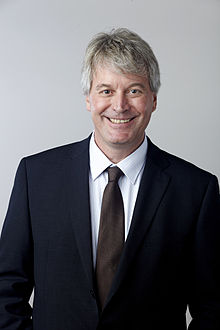Timothy Eglinton
Tim Eglinton | |
|---|---|
 Timothy Eglinton at the Royal Society admissions day in London, 2014 | |
| Born | Timothy Ian Eglinton |
| Alma mater |
|
| Scientific career | |
| Fields | Geology Carbon cycle Sedimentology[1] |
| Institutions | |
| Thesis | An investigation of kerogens using pyrolysis methods (1988) |
| Website | www |
Timothy Ian Eglinton FRS[2] is a professor of biogeoscience at the Geological Institute, ETH Zürich.[3]
Education[edit]
Eglinton was educated at Plymouth Polytechnic where he was awarded a Bachelor of Science degree in environmental science in 1982. He went on to study at Newcastle University, where he was awarded a Master of Science degree[when?] and a PhD in 1988 for research investigating kerogens using pyrolysis.[4]
Research and career[edit]
Eglinton's research[1][3][5][6][7][8][9][10] is:
focussed on understanding of the processes that govern the Earth's carbon cycle from the molecular level to the global scale, and on the legacy of past biological activity and environmental conditions contained in organic signatures preserved in the geologic record.[11]
Eglinton has revolutionised studies of Earth's carbon cycle.[2] By developing an entirely new means of tracing the pathways of organic carbon in surface environments, ranging from eroding landforms to rivers, floodplains, the oceanic water column, microbial communities and marine sediments, he has replaced countless estimates and assumptions with accurately known transport times and carbon budgets.[2] His findings have illuminated and reconciled formerly discrepant paleoclimatic records, revealed new forms of microbial life, demonstrated that microorganisms can attack and remobilise billion-year-old organic material, and traced the pathways of petroleum-derived carbon in surface environments.[2]
Awards and honours[edit]
Eglinton was elected a Fellow of the Royal Society (FRS) in 2014.[2]
Personal life[edit]
Eglinton is the son of the organic chemist Geoffrey Eglinton.[2][12][13] He is married to Lorraine Eglinton, and has two daughters and one son.[citation needed]
References[edit]
- ^ a b Timothy Eglinton publications indexed by Google Scholar
- ^ a b c d e f Anon (2014). "Professor Timothy Eglinton FRS". London: Royal Society. Archived from the original on 25 August 2017. One or more of the preceding sentences incorporates text from the royalsociety.org website where:
“All text published under the heading 'Biography' on Fellow profile pages is available under Creative Commons Attribution 4.0 International License.” --Royal Society Terms, conditions and policies at the Wayback Machine (archived 2016-11-11)
- ^ a b Timothy Eglinton publications indexed by the Scopus bibliographic database. (subscription required)
- ^ Eglinton, Timothy Ian (1988). An investigation of kerogens using pyrolysis methods (PhD thesis). Newcastle University. OCLC 18424031. EThOS uk.bl.ethos.380730.
- ^ Goñi, Miguel A.; Ruttenberg, Kathleen C.; Eglinton, Timothy I. (1997). "Sources and contribution of terrigenous organic carbon to surface sediments in the Gulf of Mexico". Nature. 389 (6648): 275–278. Bibcode:1997Natur.389..275G. doi:10.1038/38477. S2CID 4413505.
- ^ Gustafsson, Örjan; Bucheli, Thomas D.; Kukulska, Zofia; Andersson, Mette; Largeau, Claude; Rouzaud, Jean-Noël; Reddy, Christopher M.; Eglinton, Timothy I. (2012). "Evaluation of a protocol for the quantification of black carbon in sediments". Global Biogeochemical Cycles. 15 (4): 881–890. Bibcode:2001GBioC..15..881G. doi:10.1029/2000GB001380.
- ^ Goñi, Miguel A.; Ruttenberg, Kathleen C.; Eglinton, Timothy I. (1998). "A reassessment of the sources and importance of land-derived organic matter in surface sediments from the Gulf of Mexico". Geochimica et Cosmochimica Acta. 62 (18): 3055–3075. Bibcode:1998GeCoA..62.3055G. doi:10.1016/S0016-7037(98)00217-8.
- ^ Eglinton, T. I.; Aluwihare, L. I.; Bauer, J. E.; Druffel, E. R.; McNichol, A. P. (1996). "Gas chromatographic isolation of individual compounds from complex matrices for radiocarbon dating". Analytical Chemistry. 68 (5): 904–12. doi:10.1021/ac9508513. PMID 21619188. S2CID 29957103.
- ^ Sauer, Peter E.; Eglinton, Timothy I.; Hayes, John M.; Schimmelmann, Arndt; Sessions, Alex L. (2001). "Compound-specific D/H ratios of lipid biomarkers from sediments as a proxy for environmental and climatic conditions". Geochimica et Cosmochimica Acta. 65 (2): 213–222. Bibcode:2001GeCoA..65..213S. doi:10.1016/S0016-7037(00)00520-2.
- ^ Eglinton, T. I. (1997). "Variability in Radiocarbon Ages of Individual Organic Compounds from Marine Sediments" (PDF). Science. 277 (5327): 796–799. doi:10.1126/science.277.5327.796. S2CID 54810484.
- ^ Professor Dr. Timothy Ian Eglinton, Geologisches Institut, ETH Zürich
- ^ Anon (2014). "Eglinton, Prof. Geoffrey". Who's Who (online edition via Oxford University Press ed.). A & C Black. doi:10.1093/ww/9780199540884.013.U282026. (Subscription or UK public library membership required.)
- ^ "Timothy I. Eglinton". whoi.edu. Woods Hole Oceanographic Institution.
![]() This article incorporates text available under the CC BY 4.0 license.
This article incorporates text available under the CC BY 4.0 license.
